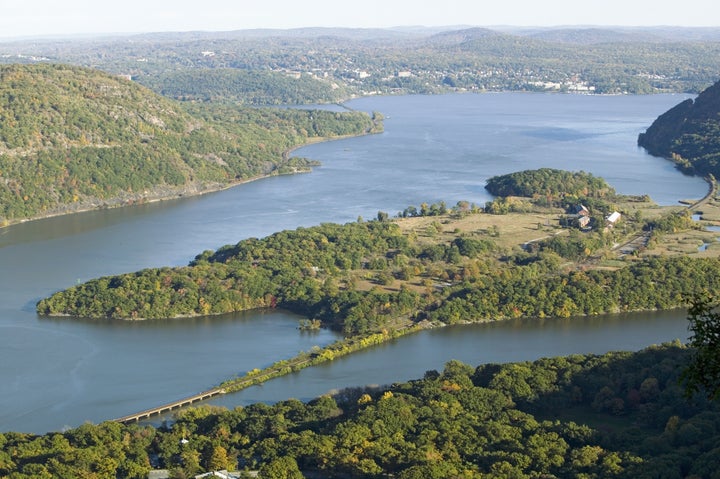
A hummingbird, its' wings ceaselessly spinning, hovers, prevaricating between two remaining flowers surely among the last blooms of a triumphant summer season. These the fragrant finale of a prolific period along the shale festooned banks of the river Hudson. Enabled by early spring rains that nourished these fertile shores ensuring plentiful bounty for all the natural world that share in it's copious and at times Darwinian feast.
This tiny emerald aviator is one of the more gentle inhabitants of this often rugged and, despite settlement efforts, mostly defiantly untamed wilderness. A place where white headed eagles, amongst other birds of prey, hang suspended overhead or vigilantly survey from lairs deftly engineered in soaring upper perches of the imposing trees that line the river's flow. Foxes and the occasional coyote prowl beneath these in hopeful wait for rabbits and other small creatures who may stray too far from their burrows. Turkeys anxiously foster expanding broods, cautiously articulating through the brush in measured staccato inter-generational cadence. Frogs calls punctuate the steady stream of cicada songs that perforate the thick of sultry forests. Deer gingerly pick their way amongst tall grasses indulging in the valley's copious juice laden apples, while sturgeon lie in quiet wake within the rivers depths, opaque submersed immobile shadows.
The Hudson, among the mightiest and most majestic rivers of all. The conduit of communication and commerce amongst it's early residents. Still now. A vital logistical artery, it reaches north to the Great Lakes and obligingly connects these to the Atlantic Ocean. This river and its surrounding valley are among America's most cherished ecological natural settings. In the 19th century a focus on exploration, discovery and inhabitance, and their combined potential, enticed the Hudson River School artists to chronicle in vast, magnificent, tableaux this sublime region of nuanced light. The paintings not seeking to tame but romantically highlight an ideal where nature in its unharnessed formats could co-exist alongside sustaining cultivation. These assurances of aesthetic solace and pastoral abundance helped inspire the early rail lines that trace the river's meanderings on either side, cavalierly directing the outcomes of many and fortunes of some.
Among these, the naturalist John Burroughs sought out the Hudson's West banks to make his home Riverby. There in a small verdant enclave appropriately named West Park, he would build upon the teachings of Thoreau, Emerson and others who had earlier inhabited another nature, perhaps less rebellious, more contained, a pond's circle of life. However like these early proponents of the importance of connecting with the surrounding world, Burrough's sought relief amidst the wild's of nature, existence on simpler terms.
Between the valley's conifers where the Marlboro Mountains taper low Burrough's constructed a rough hewn Adirondacks style log cabin that due to its course bark covering, gained the descriptive moniker Slabsides. In this unassuming one story structure encircled by thick blue-greens of wooded forest, pungent earth and a host of natural inhabitants, Burrough's contemplated life of "a different flavor", where "complex equations all disappeared". In this setting, released from the fetters of daily living he would painstakingly develop his many-tomed treatise on nature and its cycles, providing the framework for the mapping of modern
environmentalism.
Since Burroughs' time much remains the same in this small region along the Hudson. In part due to the establishment of the John Burroughs Sanctuary that safeguards a large tract of wilderness that encircles the area where he worked and lived, but also because Hudson's left bank shows little inclination of acquiescence towards the domestication and gentrification as eventually engendered along its eastern shore. Despite the best efforts of generations the land mostly prevails, dictating the twist of a tree, the turn and trickle of a stream towards the rivers open embrace, fostering sprigs of blackberries in its wake. It runs across the banks of shale worn smooth by breaking waves and endless ebb and flow of wakes and tides and joins in
the river's stream. As the waters course together and seamlessly intertwine, John Burroughs'
observations and recordings become proximately resonate. Both the greatness and eternalness of the savage power of nature's wilderness as well as the ephemeral aspect of man's contributions.
The hummingbird sucks up the last of the summer nectar reluctant to leave this paradisical delirium, it nods in deference to the ragged cool that edges the last of the summer breezes. The sheen of its incandescent feathers flash as it turns catching the lingering sun rays that illuminate the radiant crests and ridges of the surging river.